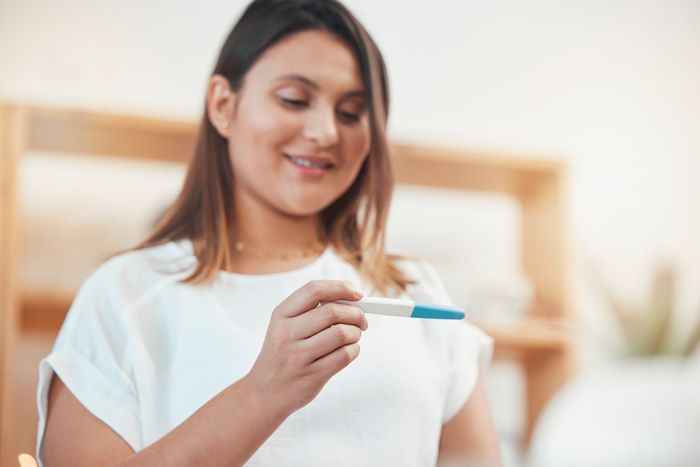Ovulation Test 101: How to Read & Interpret Each Type
How to Read Different Types of Ovulation Tests: A Step-by-Step Guide
Published November 3, 2023.

A recent survey raised concerns about the need for more awareness among women regarding ovulation and Ovulation Predictor Kits (OPKs), as 47% said they were unfamiliar with the idea.
This comprehensive guide sheds light on the details of interpreting these tests. You'll explore different types of OPKs, see common myths, and learn why they're essential.
Types of Ovulation Tests
If you've just started, you might've found the following types of tests:
- Digital Tests: User-friendly options providing results through symbols like smiley faces.
- Fertility Monitors: More advanced digital options that provide comprehensive readings. You insert a test strip into a reader, which acts like a fertility monitor.
- Standard Test Strips: Basic strips that display test and control lines so you can interpret an LH surge.
Which test you choose depends on how much information you need and your goals. For example, if you aim to conceive, you lean towards the digital test or fertility monitor for a more comprehensive reading.
How Strip Ovulation Tests Work
To interpret these tests accurately, you must understand the following mechanics:
- Control Line: Make sure your test shows the control line. It's an important indicator of whether the test is valid or not.
- Urine Samples: Use the first urine of the morning as it's less diluted, or as directed by the brand's test kit. Avoid excessive water intake beforehand to keep the concentration high.
- Reading the Test: Depending on the test's brand, a notably darker or even a faint second line indicates incoming ovulation.
- Decoding a Positive Result: A positive result doesn't guarantee ovulation but suggests its likelihood within 12-48 hours.
- Two-Step Testing for Precision: Consider this approach for a more detailed ovulation window.
- Considerations For Those With PCOS: Understand that a positive result may not always signify ovulation if you have PCOS.
How To Read a Strip Ovulation Test
The process of reading ovulation tests is pretty straightforward but requires some attention to detail.
Test strip brands, such as First Response, have two lines:
- Control Line: Lightly pink colored; this line only appears if the test is valid.
- Test Line: This line indicates an LH surge. A valid positive test will have this line darker than the control one.
If you're using digital tests or fertility monitors, the interpretation process is more direct, offering a simple "yes" or "no" result. While OPKs provide insights, understanding your body and cycle is crucial. With knowledge and consistency, you are better equipped to interpret the signs your body provides.
Common Misconceptions
Don't assume the test is functioning just because you see the test line, as results without the control line as a reference can mislead you. Additionally, even a faint test line can indicate a positive result.
Accuracy
The essential factor you should consider when exploring ovulation tests is accuracy.
Here's what you need to know about the precision and reliability of these tests:
- Quality Matters: Quality test strips are incredibly accurate, with most good brands claiming around 97% precision.
- Timing is Everything: Since OPKs detect LH—which surges 24-36 hours before ovulation occurs—the right timing of the test can maximize your chances of getting pregnant.
- Comprehensive Approach: If you want a comprehensive view of your fertility, combine test strips with basal body temperature (BBT) trackers like Tempdrop. This approach ensures you compare the test's results with other physiological signs and can confirm that ovulation actually happened.
Importance of Cycle Tracking
You can ensure the test is accurate by combining it with other cycle-tracking tools like cervical mucus and basal body temperature (BBT) monitors. With the combined data from test strips and physiological signs, you're not just waiting for a test strip's color to change but are engaged in interpreting your body's signals.
»Want clarity on your ovulation cycle? Discover the top reasons to start tracking ovulation today!
Best Time for Testing
The ovulation test's timing can be a game-changer in understanding your fertility.
Here are some guidelines to help you determine the best time to test:
- Standard Ovulation Window: In a standard 28-day cycle, ovulation would occur around cycle day 14 of your menstrual cycle. If the time between your periods is longer (for example a 35-day cycle), then you can assume ovulation occurs about 2 weeks prior to your next period.
- Advocate for Early Testing: By testing early, you can identify your peak fertility days and time the conception accordingly.
Tip:
You're most likely in your ovulation phase when the following indicators align:
- More mucus
- Positive OPK result
- Increase in BBT
If Things aren't Adding Up
If you've been testing for a while and have yet to succeed, consider shifting your testing schedule to begin a few days sooner. This adjusted approach can give you a clearer picture of your fertility rhythm.
» Ready to track ovulation with ease? Dive into how Tempdrop works to get started!
Seeking Medical Guidance
If the results don't meet your expectations, you should consider:
- Duration: If you've been tracking for over six months with inconsistent results, consult a qualified fertility expert. They can identify patterns in your chart that might indicate potential issues.
- Cycle Irregularities: Cycles over 34 days can suggest underlying conditions like PCOS (Polycystic Ovary Syndrome) or thyroid problems.
Charting Your Ovulation Journey
Your journey to understanding ovulation is personal, and with each step, you're learning more about the incredible rhythms of your body. Gain the proper knowledge, and you'll navigate ovulation with grace and confidence.
Ovulation Predictor Kits can help you better understand your ovulatory patterns. While invaluable, they're just one more tool in your arsenal. Pair them with other cycle tracking tools like BBT monitors and watch for your body's unique signals. As you're testing, be patient, consistent, and trust in the process.







